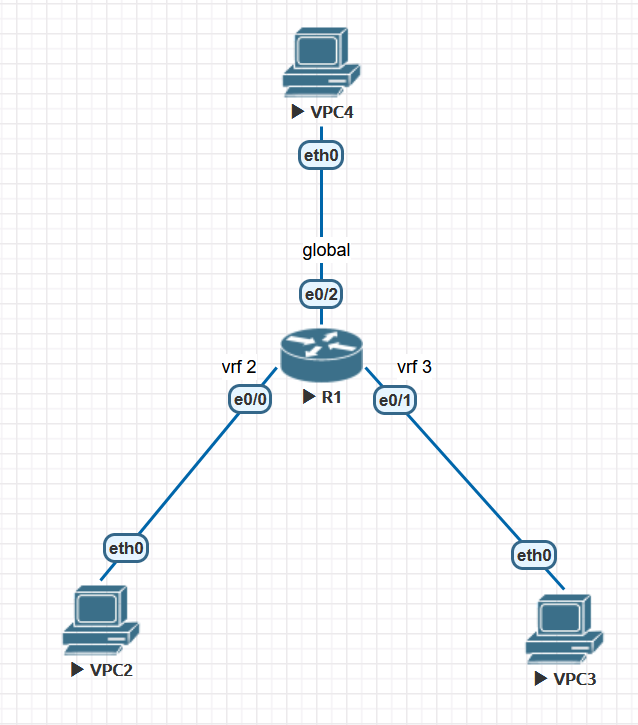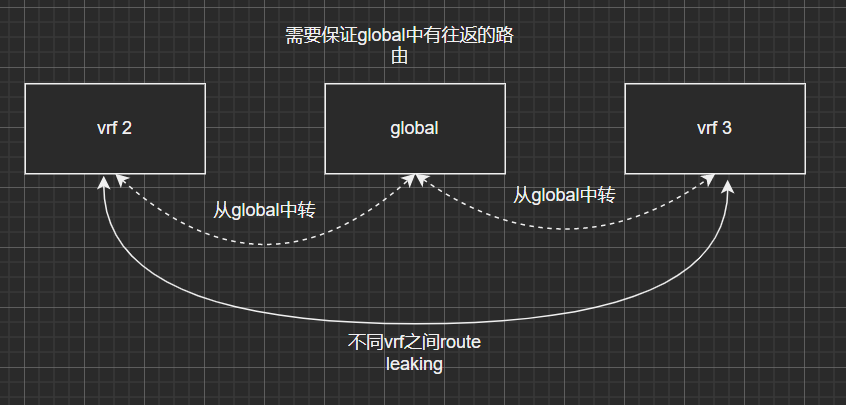写在前面 之前在vrf简述及仿真实验 对vrf有了一个基本的了解,但是vrf lite route leaking实验失败了。现在补做回来。
vrf之间的路由泄漏有静态配置和MP-BGP两种方式,本文只做静态配置的实验。
实验 之前的实验时是由于配置出的问题,参考cisco的Route Leaking in MPLS/VPN Networks , 两个vrf之间不能直接泄露路由,必须从global中转一下才行。
实验拓扑如下图所示:
vpc2属于vrf 2, vpc3属于vrf 3, vpc4属于global. 通过配置使三者之间可以相互通信。
下面开始配置。基本的ip网段配置规则按设备名称来,这里不贴出来。
1 2 3 4 5 6 7 8 9 10 R1(config)#ip vrf 2 // 创建vrf2 R1(config)#ip vrf 3 // 创建vrf3 R1(config-if)#interface ethernet 0/0 R1(config-if)#ip vrf forwarding 2 // 将eth0加入vrf 2 R1(config-if)#ip address 12.1.1.1 255.255.255.0 R1(config-if)#interface ethernet 0/1 R1(config-if)#ip vrf forwarding 3 // 将eth1加入vrf 3 R1(config-if)#ip address 13.1.1.1 255.255.255.0
测试下基本的联通性:
1 2 3 4 5 6 7 8 9 10 11 vpc4> ping 14.1.1.1 -c 1 // 可以ping通自己的网关 84 bytes from 14.1.1.1 icmp_seq=1 ttl=255 time=0.335 ms vpc4> ping 12.1.1.2 -c 1 // 不能和vrf 2通信 *14.1.1.1 icmp_seq=1 ttl=255 time=0.497 ms (ICMP type:3, code:1, Destination host unreachable) vpc4> ping 13.1.1.3 -c 1 // 不能和vrf 3通信 *14.1.1.1 icmp_seq=1 ttl=255 time=0.492 ms (ICMP type:3, code:1, Destination host unreachable)
符合预期。
对于vrf 2与global之间的通信:
1 2 3 4 5 6 R1(config)#ip route vrf 2 14.1.1.0 255.255.255.0 14.1.1.4 global // 在vrf 2中添加global中prefix的路由,global关键词表明:如果在vrf 2中收到prefix是14.1.1.0/24的报文时,到global路由表中找路由出去,由于14.1.1.0/24是global中的直连网段,所以报文可以转发 R1(config)#ip route 12.1.1.0 255.255.255.0 ethernet 0/0 // global中添加到vrf 2中prefix的路由,注意下一跳需要指定是物理接口,如果指定ip的话,不能正常路由 vpc4> ping 12.1.1.2 -c 1 // vrf 2与global之间三层可达 84 bytes from 12.1.1.2 icmp_seq=1 ttl=63 time=1.219 ms
vrf 3与global之间的通信类似配置。
1 2 3 4 5 6 7 8 9 R1(config)#ip route vrf 2 13.1.1.0 255.255.255.0 13.1.1.3 global // 在vrf 2中添加vrf 3中prefix的路由,下一跳去global中找 R1(config)#ip route 13.1.1.0 255.255.255.0 ethernet 0/1 // global中没有到vrf 3的路由,所以需要在global中添加到vrf 3中prefix的路由 R1(config)#ip route vrf 3 12.1.1.0 255.255.255.0 12.1.1.2 global // 同理在vrf 3中添加到vrf 2中prefix的路由 R1(config)#ip route 12.1.1.0 255.255.255.0 ethernet 0/0 vpc2> ping 13.1.1.3 -c 1 // vrf 2与vrf 3之间三层可达 84 bytes from 13.1.1.3 icmp_seq=1 ttl=63 time=3.980 ms
由于global中已经有了到vrf 2和vrf 3的路由,所以对于vrf 3访问global,只需要添加一条:
1 2 3 4 5 6 R1(config)#ip route vrf 3 14.1.1.0 255.255.255.0 14.1.1.4 global vpc4> ping 13.1.1.3 -c 1 // vrf 3与global之间三层可达 84 bytes from 13.1.1.3 icmp_seq=1 ttl=63 time=2.165 ms
这里面的一个基本思路是:如果一个vrf想要访问其它vrf的网段(无论是不是default vrf)
下一跳都要指定到global中去找,global中如果没有对应的路由,就要在global中补上
同时global中一定要有返回该vrf的路由
网络是双向的,来回都需要有路由。
分析下一下路由表,这是最本质的东西了:
1 2 3 4 5 6 7 8 9 10 11 12 13 14 15 16 17 18 19 20 对于vrf 2的路由表: R1#show ip route vrf 2 static 13.0.0.0/24 is subnetted, 1 subnets S 13.1.1.0 [1/0] via 13.1.1.3 // 去往vrf 3的路由,到global中找下一跳13.1.1.3 (路由表中好像并没有什么地方体现出到global去找) 14.0.0.0/24 is subnetted, 1 subnets S 14.1.1.0 [1/0] via 14.1.1.4 // 去往global的路由 // 对于global路由表 R1#show ip route static 12.0.0.0/24 is subnetted, 1 subnets S 12.1.1.0 is directly connected, Ethernet0/0 13.0.0.0/24 is subnetted, 1 subnets S 13.1.1.0 is directly connected, Ethernet0/1 // 指明13.1.1.0网段的出口 R1#show ip route vrf 3 static 12.0.0.0/24 is subnetted, 1 subnets S 12.1.1.0 [1/0] via 12.1.1.2 // 12.1.1.0的回程路由 14.0.0.0/24 is subnetted, 1 subnets S 14.1.1.0 [1/0] via 14.1.1.4
一张图来收尾吧:
最后再补充一点,vrf lite leaking有两种方式,一种就是上面使用的通过配置静态路由实现,另外一种方式就是使用MP-BG。对于MP-BGP的方式:
在vrf中表明需要import的RT
在MP-BGP对应的vrf中redistribute相关的路由

